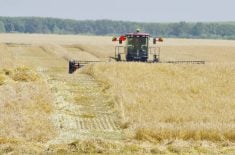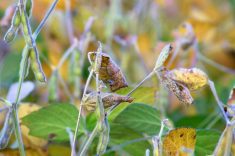Winter wheat mostly came through the bitterly cold stretches in December and January and extended chill this spring.
The first crop report of the season was mostly good news for the few farmers who got winter cereals in the ground last year.
Western Manitoba has good regrowth so far, according to the province, although some farmers in the Interlake are reseeding to spring crops due to winterkill. Central Manitoba has also noted spotty winter damage.
Lionel Kaskiw, Manitoba Agriculture production specialist in Souris and one of the speakers in the most recent Crop Talk May 9, said he has seen no problems with regrowth so far, although fields will soon be looking for rain. Most soil moisture is adequate across the province, according to the latest Manitoba Agriculture data, although Kaskiw warned soils may soon dry without rain.
Read Also

Province pledges funds to CentrePort Canada
The Manitoba government has pledged $450,000 towards projects at inland port CentrePort Canada.
That’s consistent with what Ken Gross, Western Winter Wheat Initiative agronomist, has seen.
Gross, who is based in Brandon, says most winter wheat fields look promising, although he has heard the reports of winterkill from the Interlake and near Winnipeg and Selkirk.
“It’s going to take a bit before we know exactly where we fit with all these once we get a little more moisture and heat,” he said.
The call for rain has become consistent across agricultural sectors as parts of the province remain in moderate or severe drought, according to AAFC. Dry conditions have delayed winter cereal fertilizer applications in the southwest, according to Manitoba Agriculture as farmers wait for the dry spell to break.
Anne Kirk, feed cereal specialist with Manitoba Agriculture, says she was unsurprised that so much of the winter wheat survived, despite a lack of insulating snowfall.
The province’s soil monitoring program found that temperatures mostly stayed warm enough at crown depth.
“In general, the winter survival based on the model that we used did look quite good because the soil temperature at the crown didn’t dip too low,” she said. “At one of the fields, we did have some concerns because there were some times where the soil temperature dipped below where we thought the plant was hardened off to. My major concern this year was when we did have those really cold temperatures in April because it did warm up. The plant would have ‘de-hardened’ a bit and then experienced those cold temperatures.”
Both farmers and experts suggest the spotty winterkill can be blamed on the extended cold this spring rather than mid-winter weather.
“As winter progresses, the winter wheat starts losing more winter hardiness and late winter just wouldn’t stop,” Doug Martin, Winter Cereals Manitoba chair, said. “We had a lot of freezing, thawing and cold weather. It’s generally felt that the cold winter didn’t do the damage as much as the spring.”
Martin said he has heard some of his neighbours near Selkirk complaining about damage, although most have resolved to leave the crop in rather than replant.
“It can come back quite a bit with proper management, good fertility and good weed control. You get it to bounce back pretty good,” he said.
Gross is advising farmers to wait until they are done seeding their spring cereals before deciding whether to tear up a winter cereal stand.
“We had a long winter where it had to survive on its reserves and now that it can finally start growing, it’s sitting there waiting for some moisture,” he said. “Six to seven months is a long time for a plant to sit around. We sure could use a rain.”
Gross has heard no official report on fall rye. Martin noted, however, that fall rye tends to be hardier than winter wheat.
Manitoba has few winter cereals to be impacted by the weather either way.
Statistics Canada says only 70,000 acres of winter wheat were planted last fall in Manitoba, continuing the crop’s downward slide. The crop has consistently slid for the last five years, dropping from 300,000 acres planted in fall 2013. Fall rye, meanwhile, accounted for 55,000 acres last fall, a five-year low, although only slightly below fall 2013, when 60,000 acres went in the ground.
Martin pointed to competition from crops like soybeans, which have continued to spread west and north, as well as a string of poor weather years for winter wheat’s drop.
Martin, himself, was forced to forgo the crop last year due to dry conditions, although he still champions winter wheat for what he says are economic and agronomic benefits, in particular, keeping green cover on the land before and after the normal annual cropping season.
















